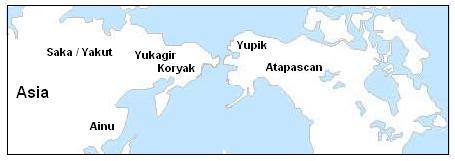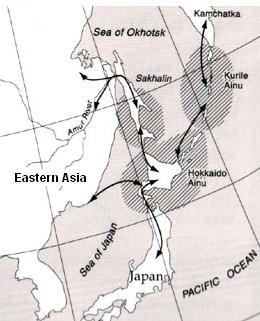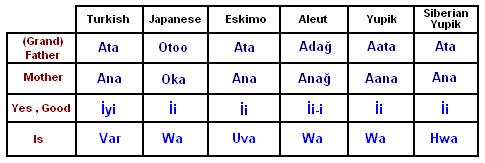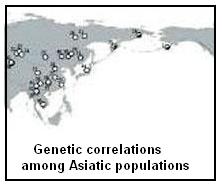|
The
expansion of Asiatic tribes through North-Eastern Asia into
North-America is a well attested fact, supported both
linguistically and genetically. We saw that the Saka people
were and are still known as the Scythians (see Chapter 4,
The Asiatic Scythians). These people are also known under
the name of Yakut. Although the origin of “Yakut” is not
clear, most probably Yaku is a transposition of
Yuka,
where “a” and “u” have changed place. The suffix –t is found
in many Turkish words. For example: kanýt, boyut, soyut,
gömüt,….etc. Another group of people next to the Yukagir are
the Koryak. This name is made of the “kor” root word and the
suffix “-yak”. Kor
means ‘ember’ and yak means
‘burn’ in Turkish, so the name Koryak can be understood as
“glowing ember”.


A recent
research done on the Ainu people showed that they migrated to
the eastern parts of Asia from the Central Asian region of
Lake Baikal, following the banks of the Amur River
(1). When
the toponymy of the region is investigated, one can find many
clues to the ancient proto-language. On the above map we find
Sakhalin, which can be split as
Saka-ilin: “the land of
the Saka”, Kurile as Kuru-il
“The dry territory”, where
kuru
means “dry” and il means “location” or
“territory”. So, Kuril becomes a meaningful description for an
island in Turkish.
The Sea of
Okhotsk can be split into its constituent phonemes as:
Okh-Ot-sk, from which the meaning “Belonging to the fiery
Okh” emerges. In that name “Ot” represents the fire or rather
the fiery human spirit as well as the sun (see Chapter 6,
Universal Symbols). A similar form of Okh is found in the
name Hokkaido, where Hokk could very well be a
transformed form of Okh and
Aido could be a
transformed form of Ainu. Other monosyllabic root word
meaning “shaman” or “spiritual leader” is
Kam, which is
found in the first syllable of Kamchatka.
All these
interesting relationships couldn’t be pure coincidence.
Moreover, the languages of the whole region, including
Japanese, have clear connections to the Altaic language group
and especially to Turkish. On the Table below 4 root words
belonging to the Eastern and Northeastern Asian languages have
been compared to Turkish.

“Ata”,
meaning grandfather or ancestor is found in almost all Altaic
languages. It is a root word originating from the
Proto-language. “Ata” is found in
atavism, whose
original meaning is “connection to and respect for the
ancestors”. Its present etymology is accepted to be linked to
atavus from Latin and
atavisme
from French. But, from the above Table we clearly see its
Eurasian origin. Although “Oka” stands alone among several
“Ana”, it clearly indicates that the shaman Ok leader was a
female in ancient times. There are several clues supporting
this claim. The above Table supports the taxonomy of languages
submitted in Chapter 1; in which the Eskimo-Aleut language
group has been classified as being at the same level and in
close relationship with the Altaic group of languages.
The last
word, which is “is” on the above Table, is worth considering
in somewhat more detail. “Is” stands for “here it is”
or “it exists” and represents a fundamental concept without
which one cannot talk about the physical world. I already
discussed the origin of “is” in Chapter 6,
Universal
Symbols. The root word var is found in Swedish as
varande “existing” and varet “matter”. In both
German and English ware stands for articles of
merchandise. Other forms are warehouse, stoneware,
glassware etc.., but the original form is
var,
which has originated from the Asiatic Proto-language.

Recently a research has shown that a distinctive sequence in
the DNA of East-Asiatic people is widespread among the so
called ‘Native Americans’ (2). The study examined 1500 people
in total and lends strong support to the idea that Native
Americans can trace their ancestry to a common founding
population in Asia. The map above shows these correlations.
A major Native American group of languages is known under the
name of Atapascan or more preferred
Atabaskan (see map
at the top of the page). Nowadays this name has been replaced
by Na-Dene
to include some non-Atabascan languages. But
the term Na-Dene is a recent creation by linguists while
Atabaskan is the original name. Atabaskan can be split into
Ata-Bashkan to mean “Ancestor-Leader” or “The language
of our leader ancestors”. |